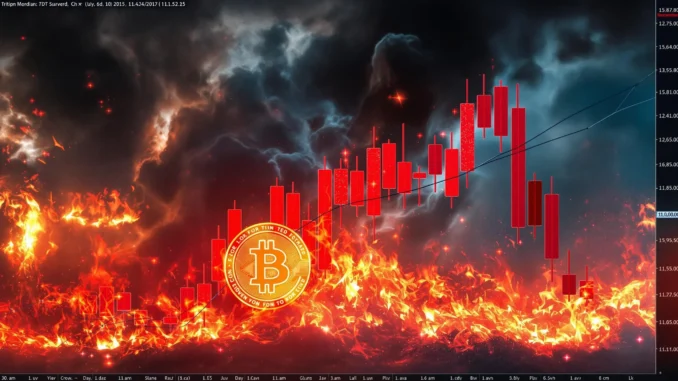
Buckle up, crypto enthusiasts! The cryptocurrency market just witnessed a seismic event. In the past 24 hours, a staggering $619.56 million worth of crypto futures positions were liquidated, sending shockwaves through the digital asset landscape. This massive wipeout, according to data from Coinglass, paints a clear picture of heightened volatility and potential market correction. Let’s dive deep into what this means for you and the broader crypto sphere.
Decoding the $619M Crypto Futures Liquidation Event
The numbers speak volumes. A whopping $619.56 million vanished from the crypto futures market in just one day. To put this into perspective, imagine the sheer scale of trading activity and market fluctuations required to trigger such a massive liquidation event. But what exactly does this liquidation entail, and why should you care?
Here’s a breakdown of the key figures:
- Total Liquidated Value: $619.56 million
- Period: Last 24 Hours
- Data Source: Coinglass
- Long Positions Liquidated: 75.2%
- Short Positions Liquidated: 24.8%
As you can see, the lion’s share of liquidations hit those holding long positions. This significant imbalance suggests a strong downward pressure on the market, leading to a cascade of liquidations as prices moved against leveraged long bets. But what are these ‘futures’ and ‘liquidations’ we keep mentioning?
Understanding Crypto Futures and Liquidations
Before we delve deeper, let’s demystify some key terms. Crypto futures are essentially contracts that allow traders to bet on the future price of cryptocurrencies without actually owning the underlying assets. Think of it as placing a wager on whether Bitcoin or Ethereum will go up or down in value at a future date.
Now, add leverage to the mix. Futures trading often involves leverage, which is like borrowing money to amplify your trading position. While leverage can magnify profits, it also dramatically magnifies losses. This is where liquidation comes in.
Liquidation happens when the price of the cryptocurrency moves against a trader’s leveraged position to the point where their margin (the initial capital they put up) can no longer cover potential losses. The exchange then automatically closes the trader’s position to prevent further losses, resulting in liquidation. In simpler terms, it’s like a forced ‘margin call’ in traditional finance, but often happening much more rapidly in the volatile crypto markets.
Why Did This Massive Cryptocurrency Market Liquidation Occur?
Several factors could have contributed to this significant cryptocurrency market liquidation event. Here are some potential triggers:
- Sudden Price Drops: Sharp and unexpected price declines in major cryptocurrencies like Bitcoin and Ethereum are often the primary catalysts for liquidations. These drops can be triggered by various events, including negative news, regulatory announcements, or whale selling activity.
- Market Volatility Spike: The crypto market is notorious for its volatility. Increased market volatility can lead to rapid price swings, triggering liquidation cascades, especially when traders are using high leverage.
- Over-Leveraged Positions: Many traders, particularly in the highly speculative crypto market, tend to use high leverage to maximize potential gains. However, this strategy significantly increases the risk of liquidation. When the market moves against them, these over-leveraged positions are the first to be wiped out.
- Domino Effect: Liquidations can create a domino effect. As large positions are liquidated, it can further push prices down, triggering more liquidations and exacerbating the initial price drop.
Long Positions Dominated: What Does It Mean?
The data reveals that 75.2% of the liquidated positions were long positions. This dominance of long liquidations offers crucial insights into the recent market dynamics.
Long positions are bets that the price of a cryptocurrency will go up. The overwhelming majority of long liquidations suggests that a significant number of traders were positioned for upward price movement, and the market moved sharply against them. This could indicate:
- Bearish Market Sentiment: The market sentiment might have shifted towards bearishness, with a prevailing expectation of price declines.
- Profit Taking or Correction: Following a period of potential gains, some investors might have decided to take profits, leading to a price correction and triggering long liquidations.
- Unexpected Negative News: Unforeseen negative news or events could have suddenly dampened market enthusiasm and spurred a sell-off, impacting long positions disproportionately.
Impact of Crypto Futures Liquidation on the Market
Crypto futures liquidation events, especially on this scale, can have significant repercussions for the broader cryptocurrency market:
- Increased Volatility: Liquidations contribute to and amplify market volatility. The forced selling of liquidated positions can exacerbate price swings, creating a more turbulent trading environment.
- Price Drops and Corrections: Large-scale liquidations often lead to price drops or deeper market corrections. The sudden influx of sell orders from liquidations puts downward pressure on prices.
- Sentiment Shift: Major liquidation events can negatively impact market sentiment. Traders may become more cautious and risk-averse, leading to reduced trading activity and potentially further price declines.
- Potential for Market Instability: In extreme cases, repeated or cascading liquidations can contribute to market instability and even flash crashes, although regulatory mechanisms and exchange safeguards aim to mitigate such extreme scenarios.
Navigating the Volatile Cryptocurrency Market: Actionable Insights
So, what can you learn from this crypto futures liquidation event? Here are some actionable insights for navigating the often-turbulent cryptocurrency market:
- Manage Your Leverage Wisely: High leverage is a double-edged sword. While it can amplify gains, it dramatically increases your risk of liquidation. Consider using lower leverage, especially in volatile market conditions.
- Use Stop-Loss Orders: Implement stop-loss orders to limit potential losses. A stop-loss order automatically closes your position if the price reaches a pre-determined level, helping you avoid catastrophic liquidations.
- Stay Informed and Monitor the Market: Keep abreast of market news, trends, and potential risk factors. Understanding market dynamics can help you make more informed trading decisions and anticipate potential volatility spikes.
- Diversify Your Portfolio: Don’t put all your eggs in one basket. Diversifying your crypto portfolio across different assets can help mitigate risk and reduce the impact of volatility in any single asset.
- Understand Risk Tolerance: Be realistic about your risk tolerance. Crypto trading, especially futures trading, is inherently risky. Only invest what you can afford to lose, and don’t let emotions drive your trading decisions.
Conclusion: A Stark Reminder of Cryptocurrency Market Risks
The $619 million crypto futures liquidation event serves as a stark reminder of the inherent risks and volatility within the cryptocurrency market. While the potential for high returns is alluring, the reality of sudden and significant market corrections, leading to massive liquidations, is ever-present.
For traders, especially those involved in futures trading, risk management is paramount. Understanding leverage, utilizing risk management tools like stop-loss orders, and staying informed are crucial for navigating these choppy waters. The crypto market offers immense opportunities, but it demands caution, knowledge, and a well-defined trading strategy. Stay safe and trade smart!



